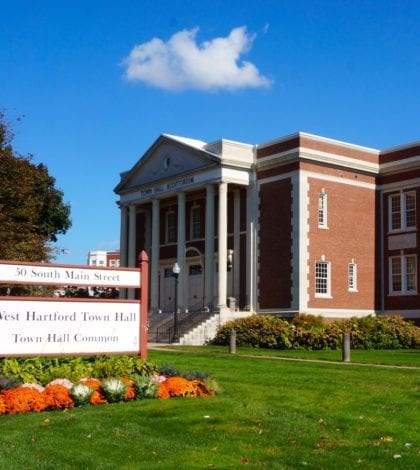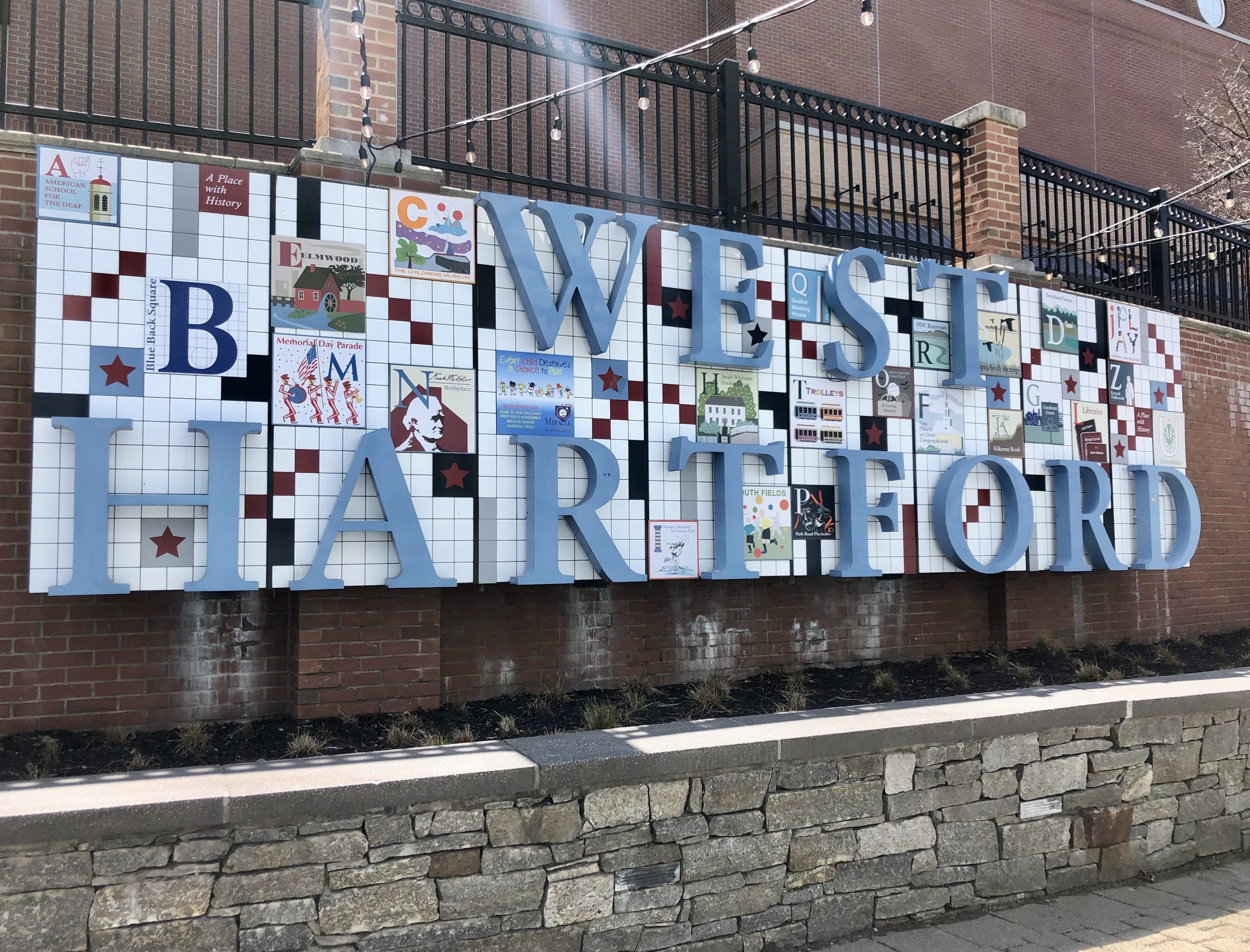Governor’s Compromise Budget Restores Millions in ECS Funding to West Hartford

Audio By Carbonatix

West Hartford Town Hall. Photo credit: Ronni Newton
Gov. Dannel P. Malloy unveiled details of a new budget proposal Friday morning which still cuts millions in aid to West Hartford in comparison to the previous fiscal year, but unlike other budget proposals returns millions in ECS funding.
By Ronni Newton
A budget proposal released by Gov. Dannel P. Malloy Friday morning cuts aid to West Hartford from FY2017 levels, but at a level that is far less draconian than budgets he floated earlier this year as well as the executive order released Aug. 18 – a measure that would completely wipe out the town’s nearly $21 million in Educational Cost Sharing (ECS) funds.
In a news release distributed Friday morning, Malloy said the latest proposal is intended to be a compromise agreement that “achieves dramatic structural change geared at stabilizing Connecticut’s finances over the long-term, while also being responsive to concerns voiced in recent months by legislators, town leaders, and recipients of state aid.”
West Hartford received a total state aid package of $25,499,051 in FY2017, which ended June 30, 2017. The governor’s latest budget would provide a total of $19,665,889 in aid – a combination of ECS, a municipal assistance grant, and several other grants – but would also require the town to reimburse the state for a portion of the employer share of teacher pensions costs, and phase that in over two years. In FY2018, the total due for teacher pension costs would be $1,805,573, for a net aid package to West Hartford of $17,860,316.
Within that aid package, West Hartford’s ECS will decrease from $20,961,352 in FY2017 to $16,435,404 in FY2018.
Statewide, the latest proposal increases municipal aid by $850 million in FY2018 from the levels outlined in the governor’s Aug. 18 executive order.
It’s no secret to the public that the state has been far from passing its budget for months, and when the Town Council adopted its $285.4 million budget on April 25, a $7 million contingency fund was included.
“We made an assumption and it was not on a whim,” Mayor Shari Cantor said of the budget adopted by the Council. “The state is in a tough place but we used what we thought was a reasonable number.”
Cantor, Town Manager Matt Hart, and Director of Financial Services Peter Privitera were still studying the numbers of the budget that was released Friday morning, and one major remaining question was the motor vehicle tax. The governor’s original budget proposal capped the automobile mill rate at 32 mills, a change from the FY2017 cap of 37 mills, but provided a grant back to towns to make up for the shortfall. That grant does not appear in Friday’s budget document.
Town leaders have not been confident that the 32 mill automobile cap would stick in any budget adopted by the legislature and signed by the governor. “We have delayed getting our bills out because of the uncertainty. We want to make sure we are billing the right amount, and also not spending more money on another billing,” Cantor said.
“In terms of the town’s ability to accommodate the most recent proposal, particularly in comparison to the most recent executive order we will be in a much better position to manage this. The town set aside a $7 million contingency in case of a revision in state aid,” said Hart. He was not involved in the budget process this spring, and assumed the role of town manager in July following the retirement of Ron Van Winkle.
After an initial review of the latest budget proposal, Privitera said it appears that West Hartford will receive $8.8 million less in aid than anticipated in the adopted budget, and with the required payment of $1.8 million in teacher pension costs, the town is looking at a shortfall of about $10.6 million, some of which will be covered by the $7 million built-in contingency fund.
Maintaining the 32 mill rate on automobiles would leave a $3.6 million hole to fill in the general fund, but if the town is permitted to charge a 37 mill rate for automobile taxes, Privitera said the town would have a gap of about $1 million.
“I’m not thrilled but we did plan, and it was a very well thought out plan that we would be able to manage,” Cantor said.
“It appears to be a more manageable problem, but the devil is the details,” Hart said.
If there’s no longer a cap on the mill rate towns are permitted to charge for motor vehicles, and the legislature allows the overall mill rate to be amended, both Cantor and Privitera said there’s a chance that West Hartford’s overall mill rate may even be reduced from 41.04.
The automobile mill rate is “the big question” in the budget. “We’re trying to find an answer,” Hart said.
While it’s still premature to predict the budget the legislature will ultimately pass, Hart said this is a step in the right direction and he appreciates the thought and consideration – and hard work – that led to a proposal that doesn’t completely decimate the town.
“West Hartford is not just West Hartford Center,” Cantor said. “We’re a very diverse community and we serve the needs of all of our children.”
That message is one that Cantor has been tirelessly delivering since the budget process began. She’s written letters, had meetings, testified at the Capitol, and even called the governor directly on multiple occasions. “I’ve talked to everyone. I hope it helped to get the message across,” she said.
“We didn’t panic. We were measured and worked really hard with the powers that be in the best way possible, demonstrating leadership and stability, working within the structure with the goal of preserving our high quality of education, our commitment to public safety, and our quality of life while mitigating the burden on taxpayers,” Cantor said.
Friday’s proposal is much more favorable to West Hartford than previous proposals have been. And not every town has been so lucky. Nearby towns like Avon and Glastonbury are still seeing the majority of their state aid eliminated, and there are other communities in the state that not only are getting zero aid, but will be writing a check to the state as their share of the teacher pension plan, Privitera said.
“We’ve done a lot of right things,” said Cantor. “There’s really no low-hanging fruit that can be eliminated and allow us to preserve our public education system.”
With a ranking of 128 out of 169 in per pupil costs, West Hartford Public Schools has been able to remain one of the highest ranked districts in the state while serving a diverse population. “That should be emulated,” said Cantor.
And while Cantor says there is no question there is more work that can be done for the town to achieve savings, she said that many strides have been made. Last year’s decision to bring the paramedic service in house through the fire department, for example, has been profitable, she said.
Overall, Cantor said that the latest proposal shows that the governor is willing to compromise in certain areas, while remaining committed to sharing teacher pension costs, eliminating a shortfall, and keeping Hartford viable through more than $200 million in ECS and a new “municipal assistance grant” of $56.6 million.
She said she believes that the governor now understands that West Hartford has a diversity of income levels, but at the same time he is looking for more regional support by surrounding communities. “We are not immune to Hartford’s problems. We share them,” said Cantor.
The balanced budget would raise revenue in part through an increase in the sales tax from 6.35 percent to 6.5 percent, and increase the sales tax on restaurants to 7 percent. An earlier proposal to tax hospital property has been replaced by an increase in the state tax on providers.
While the proposed tax levels have been set to remain competitive with surrounding states, Cantor said she thought the restaurant tax was going to be structured as an option for towns to impose, and that the revenue would go to the towns.
“This doesn’t give the flexibility and diversity of revenue that municipalities were looking for. It’s state aid or property taxes,” Cantor said.
Of course the budget proposal is just that – a proposal – and one which State Rep. Derek Slap, a Democrat who represents West Hartford’s 19th district, doesn’t think will pass as is.
For the town, he said, “A $7 million cut is better than a $24 million cut,” but there are many other towns across the state that still don’t fare well and their representatives in the legislature are not likely to approve of the plan.
“I am hoping that the next 48-72 hours will be pivotal,” Slap said Friday afternoon, regarding getting the legislature to come up with some type of bipartisan plan that is strong enough to override the governor.
“I have real concerns and I know I am not alone,” said Slap. “Protecting towns and schools would be a starting point.”
Slap said he eagerly anticipates seeing a joint house/senate proposal from state Republicans on Monday, which will likely address some additional cost savings for the state.
“It’s got to be real, it’s got to be balanced,” Slap said. “I’m willing to get out of my comfort zone.”
“We have to have courage – not draw lines in the sand but act with flexibility and be sincere. That’s the dream anyway,” said Slap.
Slap said he will be holding another “Representative on Your Corner” event at the Stop & Shop on Farmington Avenue on Sunday, from 3-5 p.m. Anyone is welcome to come by and share their ideas or just vent, he said.
If the state remains without a budget, the executive order will go into effect on Oct. 1, fiscally devastating some communities and resulting in a loss of tens of millions of dollars in state revenue. Slap said he hopes a budget can be finalized next week.
“People really want a budget. They really do,” said Slap. “Our deadline is now Oct. 1.”
Click here to review the governor’s entire Sept. 8, 2017, budget proposal.
Like what you see here? Click here to subscribe to We-Ha’s newsletter so you’ll always be in the know about what’s happening in West Hartford!




[…] FY 2017, West Hartford’s total state aid package was $25,634,623, of which $21,096,924 was Education Cost Sharing (ECS). The total aid package for […]